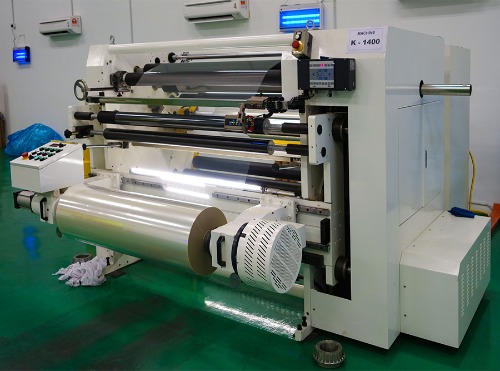
Here are the general steps to install a shaft type slitter:Choose the Installation Location: Choose a location for the slitter that has enough space to accommodate the machine and allows for easy access for maintenance and cleaning.Prepare the Site: Prepare the installation site by ensuring that the floor is clean, level and stable, and that all necessary utilities (electricity, compressed air, etc.) are available and properly installed.Assemble the Machine: Assemble the slitter according to the manufacturer's instructions. This typically involves attaching the shafts, blades, and other components to the frame, and installing the electrical and control systems.Install the Shafts: Install the shafts according to the manufacturer's instructions. This typically involves mounting the shafts in the bearings and aligning them to ensure they are parallel to each other.Install the Blades: Install the blades onto the shafts according to the manufacturer's instructions. Make sure the blades are properly aligned and tightened.Connect the Electrical Wiring: Connect the electrical wiring according to the manufacturer's instructions. Make sure to follow proper electrical safety guidelines and regulations.Test the Machine: Test the slitter to ensure that it is operating properly. This involves running a test material through the machine and adjusting the blades and tension as necessary.Perform Maintenance: Regularly perform maintenance on the slitter, such as cleaning the blades and rollers, replacing worn parts, and inspecting for any signs of wear or damage.
It is important to follow the manufacturer's instructions and safety guidelines when installing a shaft type slitter. If you are not familiar with the installation process, it is recommended to seek the assistance of a qualified technician or installer.Besides,Shaft type slitters are used in various industries for cutting materials such as paper, plastic, film, and other flexible materials. The shaft type slitter consists of a series of blades mounted on a rotating shaft, which can be adjusted to the required width of the material being cut. The material is fed through the slitter and the blades slice through the material, producing the desired width strips or sheets.
The use of shaft type slitters has several advantages over other cutting methods. Firstly, they are highly efficient and can produce large volumes of material in a short amount of time. Secondly, they can produce consistent widths and sizes of strips or sheets, ensuring that the material is of a high quality and meets the required specifications. Thirdly, they are versatile and can be used to cut a wide range of materials.Some common industries that use shaft type slitters include:Packaging industry - for cutting materials such as plastic films, paper, and cardboard into desired sizes and shapes for packaging products.Textile industry - for cutting fabrics into strips or sheets for use in clothing, upholstery, and other textile products.Printing industry - for cutting paper, vinyl, and other materials into sheets or strips for use in printing.Film industry - for cutting film into strips or sheets for use in movies, television, and other media.
In summary, shaft type slitters are highly versatile and efficient machines used in various industries for cutting a wide range of materials into consistent widths and sizes.